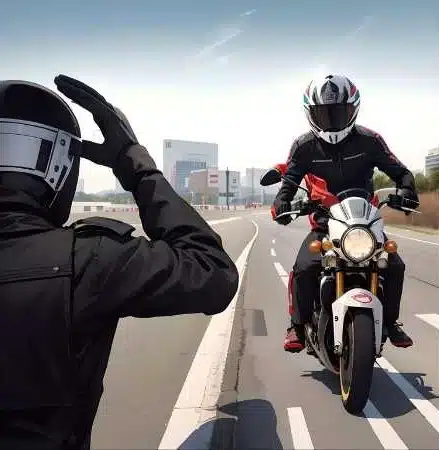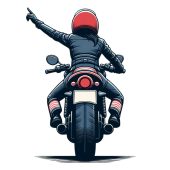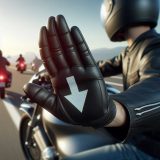Imagine you’re riding in formation with other bikers. The wind is roaring around you when suddenly, the lead rider gives a subtle tap on his helmet. What does tapping your motorcycle helmet mean? You may ask. It is not just a random gesture; it is a communication method deeply embedded in the motorcycle community.
Let’s unravel the mystery behind this simple yet significant act and explore the diverse language of rider communication. So, gear up and ride along as we decode the hidden hand signals beneath the helmet.
Table of Contents
- 1 Why do bikers tap their helmets while driving?
- 2 What should you do when you notice a helmet tap during a ride?
- 3 Is it illegal to tap your helmet?
- 4 Should you warn other motorcyclists that way or not?
- 5 What are the hand signals for motorcycles?
- 6 When you ride alone
- 7 Group Signals
- 8 Under your command
- 9 Fostering of ethical motorcycling
- 10 Conclusion: What does tapping your motorcycle helmet mean?
- 11 FAQs
Why do bikers tap their helmets while driving?
When a rider taps their helmet, it’s more than just a casual move—it’s a silent language of caution within the close-knit motorcycle community. This subtle gesture serves as a crucial warning to fellow riders, alerting them to law enforcement ahead. Picture this scenario: you’re cruising down the highway with your riding buddies, enjoying the freedom of the open road. Suddenly, the lead rider taps their helmet, instantly sparking a ripple effect. It’s not a coincidence; it’s a communication code, a shared understanding among bikers that cops lie in wait around the next bend. In this section, let’s dive into the intricate world of motorcycle hand signals, particularly the helmet tap, and unveil the unspoken warnings that keep riders united on the road.

What should you do when you notice a helmet tap during a ride?
What should you do? Consider this your instantaneous call to action. As the unspoken code among bikers, the helmet tap is a discreet warning that demands a swift response. First and foremost, check your speedometer. This is not the moment for throttle bravado. Ease off the gas, glide at a smoother pace, and let caution be your co-pilot.
Is it illegal to tap your helmet?
In motorcycle camaraderie, the helmet tap serves as a crucial means of communication, often signaling the presence of law enforcement up ahead. But is there a legal gray area for conveying fellow riders cops ahead signal? It can hardly be considered illegal in a world that values freedom of expression, where “speed camera ahead” warning boards are commonplace.
Should you warn other motorcyclists that way or not?
Motorcyclists seek to strengthen their relationships with the riding community by protecting one another from legal consequences by indicating the presence of police enforcement.
On the contrary, the second perspective focuses on the ethical obligation of motorcyclists to support law enforcement in maintaining road safety. Proponents of this view argue that riders have a responsibility to contribute to the prevention of speeding and other traffic violations. By refraining from warning others about police presence, motorcyclists can play a role in discouraging reckless behavior on the roads. This perspective emphasizes the importance of individual responsibility and cooperation with authorities to ensure overall safety.
What are the hand signals for motorcycles?
Whether cruising with biker buddies or participating in group rides, understanding the hand signals is essential for a seamless and safe journey. From left and right turn signals to crucial warnings about police presence or hazards ahead, these signals are the unspoken code that binds the motorcycle community together.
















Let’s dive into motorcycle hand signals, where gestures speak louder than words, forging a connection that transcends the hum of engines.
When you ride alone
Regardless of whether your motorcycle’s turn signals are functioning correctly, it is crucial to be well-versed in the fundamental hand signals used in motorcycle riding. Integrating biker hand signals alongside operational blinkers enhances the clarity of your intentions on the road.
Indicate to turn left:
Picture this scenario: You’re traveling down the road and must make a left turn at an upcoming beautiful intersection. Instead of just relying on your blinker, let the universal hand signals of motorcyclists come into play.
Extend your left arm horizontally straight for a few seconds. This signal will provide a clear and unmistakable indication to the traffic behind you that you intend to turn left.

Engaging in a turn to the right:
As you approach the intersection or winding roads demanding a shift to the right, indicate to turn right by raising your left arm, bent at the elbow, forming an upward angle. This straightforward hand signal is a clear message to the surrounding traffic, indicating your intent to turn right.
Come to a complete stop:
Signal to stop is a vital gesture that ensures the safest pause for solo riders. When the need to stop arises, lower your left arm, bent at the elbow, forming a downward angle, the palm facing the rear, signaling a gradual and controlled stop.
Group Signals
Master the group riding signals and incorporate these motorcycle communication methods within your riding community.
Refreshment Stop:
The “Need to Drink” hand signal reminds your fellow riders that it’s time for a refreshing stop. To communicate this essential need, bend your left arm, close your fist, and move your thumb towards your face. It indicates a drinking gesture, bringing an imaginary beverage to your lips and prompting that it’s time to find a suitable spot for refreshment.
Whether you’re leading the pack or riding information, incorporating this hand signal ensures that every journey is not just about the destination but also the shared moments of refreshment along the way.
Restroom Break:
Picture this: you’re cruising with your motorcycle tribe, and the desire for a restroom break sets in. To convey this, extend your left fist downward, forming a 45-degree angle with the road, and slightly shake your fist up and down.
As riders, we understand that these breaks are as much a part of the adventure as the winding roads.
Pull Off:
The “Pull Off” hand signal is crucial, signifying the collective decision to exit the highway at the next available ramp. To communicate this intention, extend your left arm with the index finger pointing at a 45-degree upward angle. In this position, move your arm forward and repeat the motion several times.

Fuel Stop:
When your tank is near empty and the need for a gas station becomes urgent, bend your left arm and point towards the fuel tank with your index finger.
This universally recognized gesture signals to fellow riders that your fuel is running low, prompting a collective awareness of the impending need for a refill.
Under your command
Slow Down:
When it’s time to decelerate, extend your left arm, palm facing down, and move your hand downward. This slow down signal communicates the need to reduce speed, prompting fellow riders to follow suit, ensuring a smooth and coordinated slowdown.

Speed Up:
When the desire for a quicker tempo sets in, extend your left arm with your palm facing upward and move your hand upward. This speed up signal communicates the need for acceleration, prompting fellow riders to embrace a swiffer pace.
Follow Me:
Gear up, embrace the responsibility of leadership, and let the “Follow Me” hand signal symbolize unity and shared exploration within the dynamic community of motorcycle enthusiasts.
When ready to take the lead, raise your left arm up, palm facing forward.

Change in the lead:
To signal this change, extend your left arm with a waving motion of the left index finger, indicating to fellow riders that it’s time for a new leader to take charge.
Single Formation:
The “Single File” hand signal is a subtle directive motorcycle riders use to signal a transition into individual formation. To convey this intention, extend your left arm with a 90-degree bend at the elbow and point your left index finger upward. This gesture indicates that fellow riders should align themselves in a single-file formation.

Double Formation:
The “Double File” hand signal directs fellow riders to transition into a two-abreast or double-file formation. To communicate this intent, extend your left arm, maintaining a 90-degree bend at the elbow, and point with both your left index and middle fingers upward.
This gesture effectively communicates the need for riders to align themselves side by side. Like the “Single File” signal, the “Double File” hand signal is an efficient means of coordination, allowing riders to adjust their formation without relying on verbal instructions.

Fostering of ethical motorcycling
In this section, discover how motorcyclists contribute to a culture of shared responsibility through riding etiquette and ethical practices on the road.
Hazard Ahead Signal:
When you spot a hazard on the road, extend your left arm and point with your left index finger to the side where the obstacle is located. This gesture communicates a clear warning, prompting riders to navigate the hazard cautiously. Integrating the “Hazard Ahead” signal into your riding lexicon fosters a culture of shared responsibility and safety.

You left your blinker on:
In the melodic journey of motorcycle riding, even the most seasoned riders can overlook the finer points. The “Your Blinker is On” signal serves as a friendly gesture, ensuring the rider behind is informed about the status of his blinker. To convey the message “You left your blinker on,” stretch your left arm out, open, and close your fist, indicating to the rider behind that his turn signal is still activated. This universally recognized gesture prevents confusion and promotes a smooth, coordinated riding experience.
Demonstrating respect in motorcycling:
When encountering a fellow rider on the road, a subtle nod or a two-finger wave becomes an unspoken salute, recognizing the shared passion for the open road. This gesture signifies a connection between individuals and a nod to the larger community that defines the spirit of two-wheeled adventures.

Conclusion: What does tapping your motorcycle helmet mean?
These universal hand signals represent the lifeblood of our rides; they are far more than just gestures. They create silent communication among riders, from signaling turns to showing respect. Learning these signs, whether by yourself or in a group riding, is a commitment to safety and cooperation. Thus, prepare yourself, ride vigilantly, and allow the unwritten language of the road to direct your travels to ensure every experience is a perfect fusion of discovery, community, and the pure joy of the trip.
FAQs
What's the biker's sign of respect?
The biker’s sign of respect is the classic two-fingered point down to the ground. It symbolizes the connection between bikers and the road, a gesture that runs deep in motorcycle culture.
Where did the biker's sign of respect come from?
The origin of the biker’s sign of respect isn’t precisely documented. Its history is deeply rooted in the traditions and motorcycle brotherhood culture. However, there are two theories: one suggests it comes from the AMA (American Motorcycle Association), and the other proposes that it originates from Harley Davidson.
What are the alternatives to motorcycle hand signals?
Many motorcyclists use intercom systems, which let them talk to each other using the speakers and microphones already installed in their helmets. This is especially helpful when riders are in a group or using the same bike.
Riders can connect their cell phones or other Bluetooth-enabled gadgets to helmets and communication equipment because of the widespread integration of Bluetooth technology.

